| In 1966 an important event happened, as a
result of the Local Government Reform Act. Darlaston
lost its status as an urban district, and came under the
direct control of Walsall Metropolitan Borough. As a
result, Darlaston Urban District Council held it's last
meeting at the Town Hall on Tuesday 29th March, 1966.
When the council members attended the meeting they found
a wreath of assorted daffodils in the corridor. The
attached message read as follows:
"From the tradespeople of the
town. In Memory of D.U.D.C."
Councillor Mrs. E. E. Wilkinson, who
chaired the meeting said that "The spirit of the
Darlaston people was good, sound and independent. They
were the kind of people who see that their town was not
forgotten."

On Monday 28th March,
1966, Mrs. E. E. Wilkinson, receives a
cheque for £109 from Mr. J. E. Coad,
headmaster of Rough Hay County Primary
School, to help with the cost of a second
ambulance for the Darlaston Fellowship for
the Disabled. |

The final meeting of Darlaston's
council members, held on Tuesday 29th March, 1966.
On Saturday 26th March, 1966 seven
Darlaston councillors were elected to the Fellowship of
Darlaston and presented with commemorative caskets and
scrolls at a celebration dinner. They can be seen in the
photograph below.

Left to Right:
Back Row - Mr. J. A. Wilkes, Mr. J. A.
Smith,
Mr. F. Baker, and Mr. T. Croft.
Front Row - Mr. E. Sutton, Mrs. E. E.
Wilkinson, and Mr. T. W. Wilkinson.
|
|
|

One of the town's last council
meetings. From the collection of the late Howard Madeley. |
| In the early 1960s Darlaston Comprehensive School
opened on the area of George Rose Park that is adjacent
to Herberts Park Road.
This was part of a plan to
streamline secondary education in the town, which
resulted in the closure of Slater Street (boys), and
Salisbury Street (girls) Secondary Modern Schools.
The
school became Darlaston Community Science
College, part of Walsall LEA with just over
1,100 students, nearly 80 full time teachers and about
35 support staff.
Students actively engaged in work with
adults from many agencies that were associated with the
college.
As a result of this work in the community, the
college was awarded a School's Curriculum Award in June
2000.
In September 2009 the school became Grace
Academy, which has since expanded and taken over much of
the old George Rose Park. |

An advert from 1966. |

Darlaston flats, John Wootton
House and Great Croft House. Courtesy of Bill Beddow. |
In the mid 1960s two 15 storey blocks of flats, Great
Croft House and John Wootton House were built next to
the site of the old Wesleyan graveyard off Great Croft
Street.
This was a time of great change in the town
centre, which would soon look very different. |
|
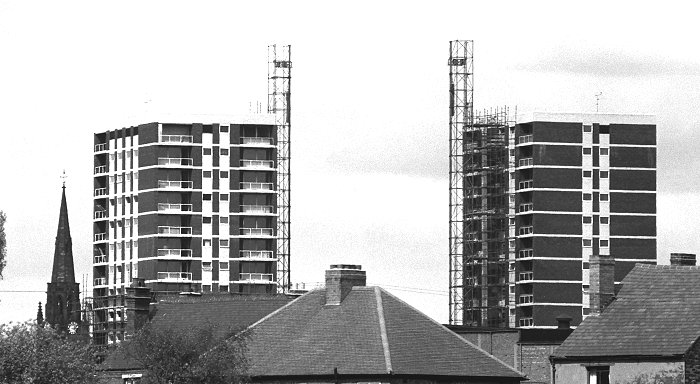
The flats near completion in 1965.
Courtesy of Bill Beddow. |

The old flats, John Wootton House
and Great Croft House, and the Bull Stake. Taken by Richard Ashmore. Courtesy of John
and Christine Ashmore. |
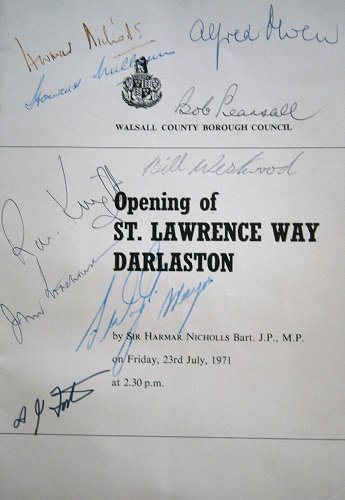 |
|
 |
| In
1970 and 1971 much of the old town centre
was demolished for the construction of St.
Lawrence Way. The casualties included Great
Croft Street, Eldon Street, and part of Bilston Street.
The two fifths of a mile length of road cost
£226,800 and was opened in July 1971 by Lord Harmar
Nicholls, a former chairman of the Council. |
|

Pinfold Street J.M.I.
School and the Wake Field from the top of the old
pit bank that used to be where the bungalows in
Wiley Avenue South are today. There were two filled-in mine
shafts on top of the bank. If you dropped a
stone into one of them it took a long time to reach
the water at the bottom. |

The Wake Field was named after
Pat Collin's fair, which came regularly to the town.
The photograph shows the fair on a cold winter's day in the
mid 1960s. The land
was owned by Pat Collins who purchased many disused
coal mines, clay pits, and sand pits in the Black
Country, levelled them and laid gravel to make a
suitable surface for his fairs. |
|

The Wake Field in the early
1970s. |

The southern edge of the
Wake Field looking towards Moxley Road. This
photograph from the early 1960s was taken from the
top of the old school air raid shelters and shows
the area that was once occupied by the old Victorian
houses and their back gardens. Immediately behind
the houses was a courtyard with a large double
gateway onto Moxley Road. |

This photograph shows the
derelict Shaw's scrap yard that stood on the western
side of the pit bank by the Wake Field. Access to
the yard was via a double gateway at the end of
Woods Bank Terrace. The scrap yard was owned by
Charlie Shaw, a generous man who used to drink in
the Moxley Arms. First thing in the evening he would
buy everyone in the pub a drink. |
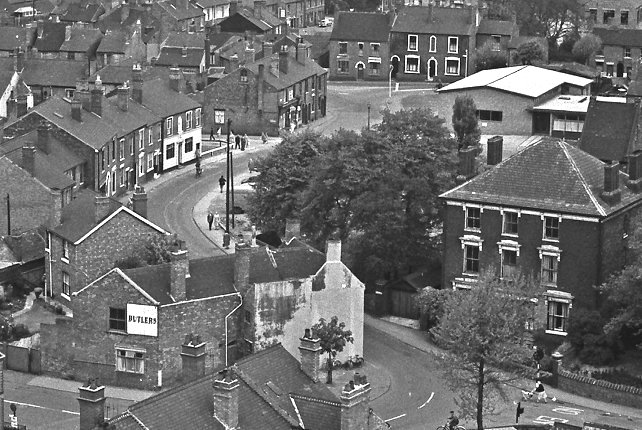
The Leys, as seen from Great
Croft House in 1965. Courtesy of Bill Beddow. The
house on the right was called Pear Tree House, but
also known as Lion House because of the cast iron
lions that were on the gate posts. It was built in
1852 by Edwin Bruerton, a wealthy pawnbroker, and a
church warden at St. Lawrence's Church from 1862
until 1884. He also owned a large house on the
corner of Cock Street and Dorsett Road, next to the
Dartmouth Arms. The pub can be seen in the centre of
the photograph, although the house was long gone.
The house became the town's first library, the
Mechanics Institute. On the left is the Seven Stars
pub, and on the right is the Leys Hall. |

An advert from 1966.
|
|
 |
|
Three
adverts from 1954. Courtesy of Christine and John
Ashmore. |
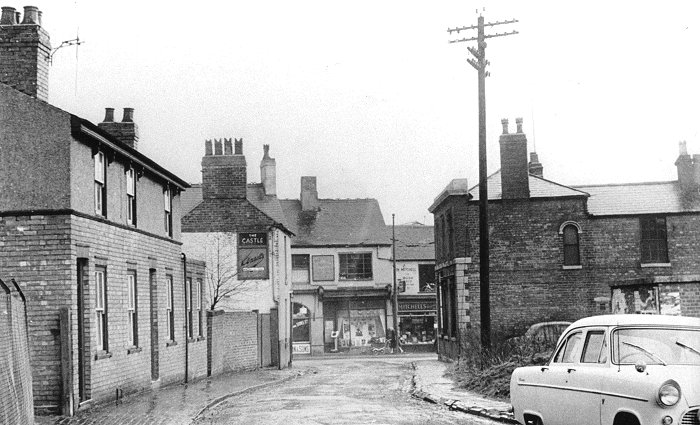
Great Croft
Street in 1963, on a wet Sunday
afternoon, looking towards Pinfold
Street. Courtesy of Irene Bishop. |
| The photograph above was kindly sent in by Irene
Bishop who lived at number 30 Great Croft Street,
the second front door on the left. This is part of
the area that was redeveloped in the early 1970s. She
recalled that this was the only house left standing
in the street, the others having been demolished
around the beginning of World War 2. Most of the
occupants were re-housed at Bentley. The site of the
houses opposite was occupied by air-raid shelters.
On the right-hand corner is Belcher's offices and on
the left is the Castle pub, which was run by the Foxalls during the war. When there was an air-raid,
Irene and her family used to go into the cellars of
the Castle instead of the nasty-smelling air-raid
shelters opposite. The small single storey building
on the extreme right behind the car is the air-raid
warden's post, which was looked after by her father,
the ARP warden. |
|

King Street in the
1960s. |
|

A trolleybus on its
way to Wolverhampton passes through Moxley
in the 1960s. Courtesy of Roger Taft. |
|
The 1970s saw a revival of the once-popular
Darlaston carnival. The first Darlaston carnival was
organised by William G. Berry in 1925 (later a
member of Darlaston Council). The annual event was
very popular. People flocked to the town to see the
parade of floats, followed by events in George Rose
Park. In 1972 Alderman Tom Croft was asked if he
could bring back "a bit of life" to the town, and
revive the dying interest in the area. As a result
three committees were set up to plan a carnival, a
fete, and entertainment for the day. It was also
seen as a means of raising money for old-age
pensioners, and the physically handicapped. The
first carnival for many years took place on Saturday
15th July, 1972 when a series of events were held
during the afternoon and evening in George Rose
Park. The carnival started from
Richards Street at 1.45p.m. as a large number of
pigeons were released. The parade then made its way
around the town before entering George Rose Park. |
|

The Bull Stake in the
early 1970s. |

In 1973 for the second
consecutive year, F. H. Lloyds entered the trade
section of Darlaston Carnival. The company's
creation 'The Southern Belle - Pride of F.H.L.',
a faithful recreation of a western style
locomotive, won first prize. From 'The Steel
Casting', courtesy of Wendy Marston. |
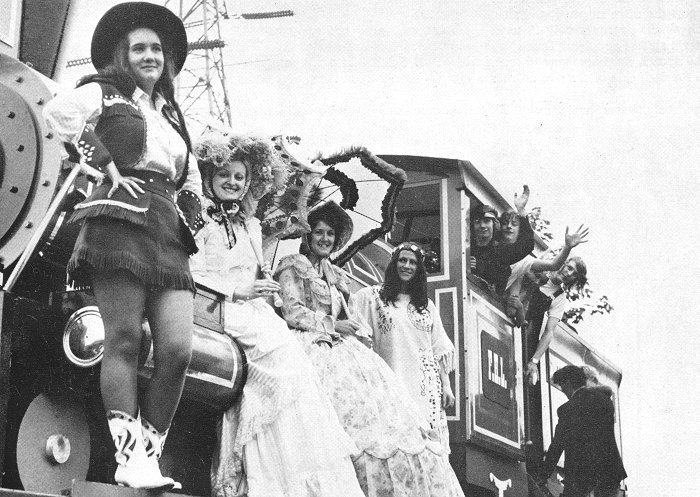
On the locomotive are,
left to right: Josie Evans, Sue Checketts,
Barbara Dolan, and Jean Manns. Some of the
apprentices are in the cab. From 'The Steel
Casting', courtesy of Wendy Marston. |
|

An advert from the
1975 programme for Darlaston Carnival. |
|

E. H. Burton & Son's
shop in King Street. |
|
Darlaston was a
wonderful place to shop. There were many
useful, well-known, and well-liked shops
in King Street before the town centre
was redeveloped. One of them, an
ironmongers, run by E. H. Burton & Son
Limited, stocked a wide range of goods
and provided a service that was second
to none. The staff were always extremely
helpful and offered good advice when
necessary. Shopping there was always a
pleasant experience. They sold a wide
range of household items including
screws, nails, electrical bits and
pieces, tools, gas cookers, heaters,
and were Darlaston's main agents for
West Midlands Gas, and for Calor Gas.
Adrian Burton also
has fond memories of the shop which
became his father's responsibility in
1963 when his grandfather Edward Henry,
known as Harry, passed away. His father
would have been about 29 at the time, so
he had a lot to take on, especially as
he had a young
family. Both of Adrian's grandmothers
helped out in the shop. Hilda Burton and
her husband Harry lived on the premises until they moved to Somerset Road,
Walsall in the 1950s. Adrian's other
grandmother
Elsie Seaman, who also helped in the
shop, lived in St Lawrence Way,
Darlaston in the flats. Her husband Harold
Herbert Seaman is thought to have worked
as a
toolmaker at GKN.
Adrian began
working life as a trainee accountant at
the Servis Washing Machine factory. It
was there that he met his wife
Michele. His elder brother
Nigel worked in the shop on
Saturdays serving the customers. During
holidays Adrian would ride in the delivery
van taking items to factories such
as F. H. Lloyds, Garringtons, Rubery Owen,
Wilkins and Mitchell etc.
Adrian remembers
that his father's shop was a
treasure trove for a young child,
selling such an odd assortment of
products. Paraffin was always popular,
as was Calor gas. On entering the shop, half way up,
there were steps to climb, to end up at
a large shop counter with a brass ruler attached
for measuring chain link, wire, or
sheeting. Also an old set of scales in
the corner by a bakelite phone where the
nails would be weighed.
His father and
grandfather were ably helped by
George Dixon who lived in Wednesbury. He
was a great help to the family, and must
have been almost 80 when
he finally retired. Adrian also
remembers that his father kept many of the shop's accounting
documents in old ammunition boxes. |
|

An advert from the
1977 programme for Darlaston Carnival. |
| The late 1970s saw changes in
Darlaston that would have been unimaginable in the
previous decade. Most of the large factories that
formed the main stay of Darlaston's industrial might
were forced out of business by the recession. This
dealt a terrible blow to Darlaston, especially as the
previous ten years were so successful. During the
next decade the large companies disappeared one by
one until a large part of the town became a derelict
wasteland. The situation wasn't helped by the fact
that tax still had to be paid on empty useable
buildings, and so the roofs were quickly removed as
factories became empty, so avoiding the tax. This
meant that the empty buildings quickly deteriorated,
became unusable, and were demolished to leave an
industrial wasteland. |
|

Building work begins on the
Leys flats. |
In the early 1970s through to 1978, much of King Street and High
Street was demolished to make way for the new ASDA
store, new shops, and a new library. Changes also
took place on The Leys with the building of two more
15 storey blocks of flats, Leys Court and Alma
Court, which were to have a relatively short life.
Part of the site covered Smith Street, and so
before work could begin, the buildings there were
demolished. |
|

Another view of the
construction of The Leys flats with Old Church
School in the background. |

The Leys flats, Alma Court and
Leys Court, nearing completion. Taken by Richard Ashmore. Courtesy of John
and Christine Ashmore. |
|

A fine view of the Leys flats.
Taken by Richard Ashmore. Courtesy of John and Christine Ashmore. |
| View images of
the town centre from the 1960s to recent times, and
a Bentley panorama: |
 |
The 1960s and the
Old Town Centre |
 |
Dereliction and
Demolition |
 |
The Late 1970s
Rebuild |
 |
The 21st Century
Rebuild |
 |
Lost Buildings |
 |
More Lost Buildings |
 |
The town in 2001
and 2002 |
 |
A Panorama of
Bentley in the early 1960s |
| With large numbers of people permanently out
of work, and little investment, Darlaston's
future looked bleak, especially when more jobs
were lost as a result of the closure of the
area's last large factory, F. H. Lloyds, which
closed in April 1990. Since that time the town
has recovered remarkably well. Nearly all of the
derelict factory sites have now gone and been
replaced with new housing estates, end even new
industries. One of today's success stories is
the rebirth of Charles Richards' Imperial Works
thanks to George Dyke Limited, which now
occupies much of the site and has built new
factory units there. The old Wilkins and
Mitchell factory on the opposite side of Heath
Road is now an industrial estate, and the
businesses in the road seem to be as busy as
ever.
Today's Station Street looks as
industrialised as ever with several new
businesses there. Until 2015, bolts were still produced in
the old GKN Atlas Works by Caparo Atlas
Fastenings Limited, which sadly went into
liquidation on 19th October, 2015. Much of the
factory is occupied by ZF Lemforder UK Limited,
which designs
and manufactures automotive suspension
components, and operates a just-in-sequence
supply of suspension assemblies.
Today few people are out of work in the town,
and the newly built houses give the area a look
of prosperity, so different to the old Victorian
terraces which were commonplace. Access to the
town improved with the building of the Black
Country Route from Bentley to West Bromwich,
which opened in mid 1995. It follows the old
Darlaston-Willenhall and Darlaston-Moxley
boundaries, and has greatly changed the eastern
end of Moxley with the large traffic island.

Christmas lights in King
Street.
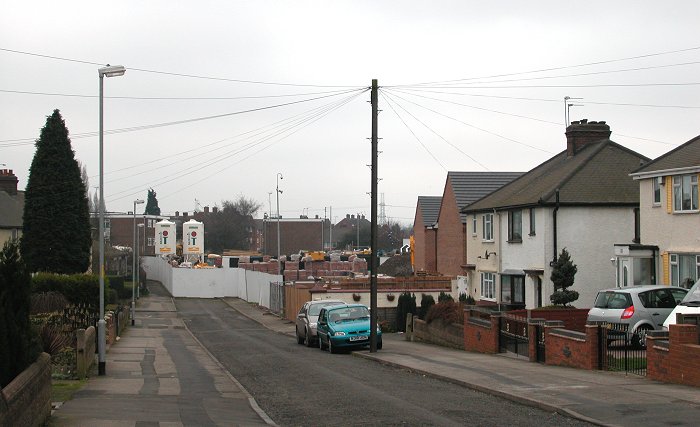
One of the
recent housing developments was the
Woods Bank housing estate on the
site of G. B. Longmore's Springfield
Works, in Mill Street, which
produced bright drawn steel. After
closure, the site was acquired by Bellway
Homes, who built the estate. |
|

Another view
of the housing estate from February
2005 when building work was well
underway. |
The new ASDA store in the town centre
attracts large numbers of shoppers. Sadly many
of the traditional shops in King Street have now
gone, but most have been replaced with new
businesses, and few are empty. Many of the old derelict
industrial areas have been revived thanks to
investment and redevelopment schemes, and very few
empty factories remain. One such scheme, the
Darlaston Heritage Economic Regeneration Scheme was
designed to restore historic buildings and
historic open spaces. Three areas that were
improved are Darlaston War Memorial, the Owen
Memorial Gardens, and Victoria Park, which received
a £67,000 facelift thanks to Walsall Council and
Darlaston Local Neighbourhood Partnership.
The Town Hall closed in September 2006 on
health and safety grounds. Thankfully Walsall Council
spent £325,000 to renovate the building, which
reopened in June 2008. To mark the opening, organist Mervyn Jones was joined by the Wolverhampton Orpheus
Male Voice Choir and popular Xylophone player Jack
Williams for a two-hour performance, which was given
to an appreciative audience of 150 people. Hopefully
the Town Hall will continue to be in use for many
years to come. It is now home to Darlaston's Sport
and Leisure Services, and there are concerts given
by Borough Organist, Peter Morris, on the Slater
Organ. |
| An interesting event took place in St. Lawrence's
churchyard on 19th October, 2014. It was the relaying and
dedication of a plaque to commemorate the renovation of the
churchyard on 20th June, 1954. The renovation had been
carried out by Darlaston Urban District Council under the
chairmanship of Councillor A. G. B. Owen C.B.E., J.P., C.C.
Sadly the original plaque was stolen in 2014 by metal
thieves, and so
David Owen kindly had a non-metallic replica made, and installed on the
site.
Quite a few people came along on a windy autumn Sunday
morning, and a short service of re-dedication was held in
the churchyard, led by the vicar, Liz Jones. |

David Owen O.B.E. and the plaque. |
|

The new plaque, kindly sponsored
by David Owen O.B.E. |
|

The service of re-dedication. Liz
Jones, Vicar of St. Lawrence's Church is on the right. |
|

Some of those who witnessed the
event. |

The party included Tony Highfield on the far left, Liz
Jones 3rd from the left, David Owen, at the back, last
but one on the right, and Bill Madeley, ex-Mayor of
Walsall on the far right. |
|

The original plaque. |
|

The dedication ceremony in 1954. |
|

Another view of the 1954 ceremony. Courtesy of Christine and John Ashmore. |
|

Bill Madeley in 2009. |
In January 2016, 82 years old Bill Madeley, who
greatly improved the town in so many ways,
died from liver cancer. He was elected as a Labour
councillor on May 13th, 1971 to represent the
Bentley ward, which later became Bentley and
Darlaston North.
He went on to become mayor of Walsall in 1988,
deputy leader of the council in 1997 and then took
on the role of leader of the council from January to
May 1999.
He was awarded an MBE in 2006 and became Honorary
Freemen of the Borough in 2010.
His funeral which was held at Emmanuel Church in
Bentley was attended by around 300 people.
He loved Darlaston and did all that he could for
the town. |
|

Moxley High Street in the
1980s. |

The old fire station in Crescent Road was
a sad sight in November, 2018.
| All-in-all Darlaston's future looks good. Hopefully
investment in the town will continue, and it can look
forward to a bright future. |
 |
 |
 |
Return to The
Post-War Years |
Return to
Contents |
Proceed to
References |
|